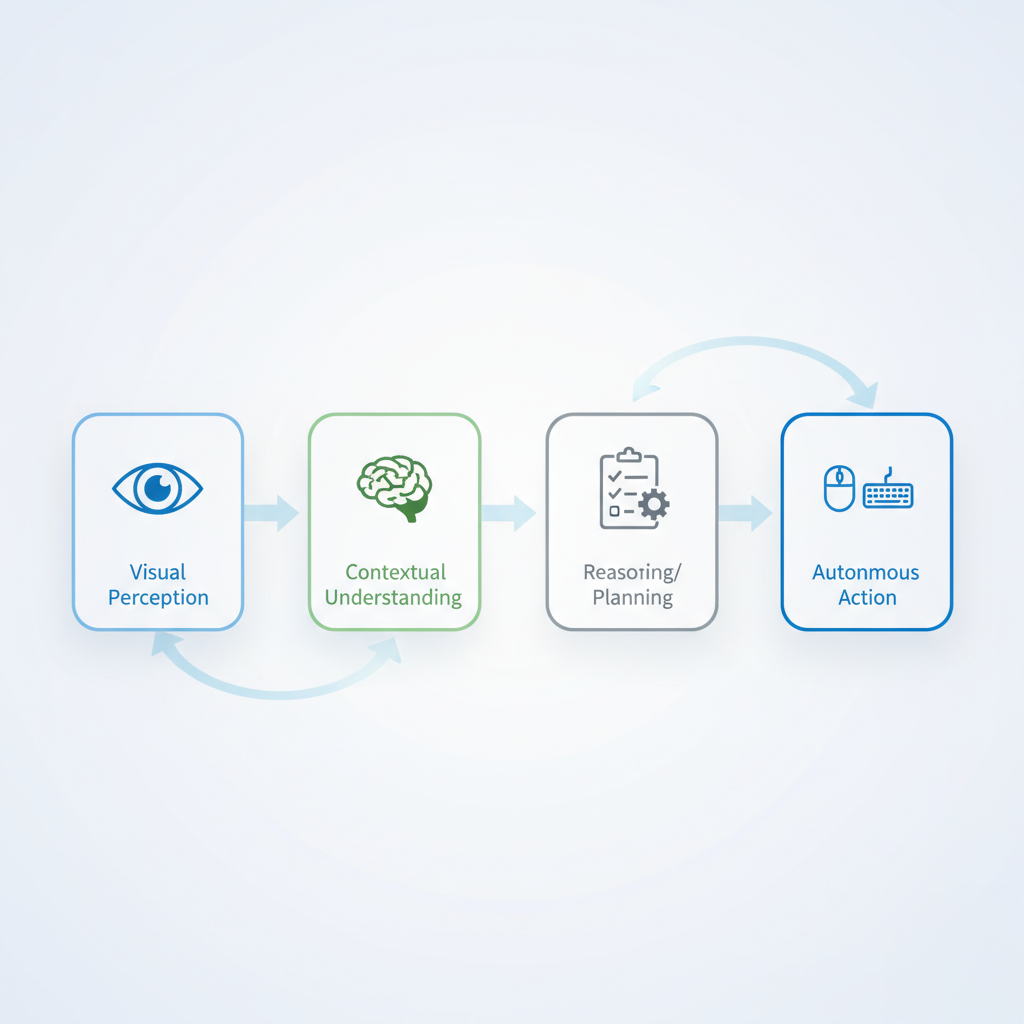The term "AI Agent" appears throughout all platforms yet true intelligence in vision remains undefined. How does an AI go from just "seeing" pixels on a screen to actually understanding a user interface the same way you and I do?As the team at AskUI, our entire platform is built around this very concept. This isn't just a glossary definition for us. The fundamental engineering challenge which our team has worked on since the beginning remains our main focus.
This guide breaks down the foundational concepts of an intelligent vision AI agent. We will cover what it is, its core components, and why this approach is the only reliable way to solve modern automation challenges. We'll also share how this concept has evolved from a single agent into a powerful autonomous platform like our new caesr.ai.
The Problem and Why "Blind" Automation Fails
To understand what an intelligent vision agent is, it's essential to first understand the problem it solves.
For decades, traditional automation like Selenium or most RPA bots has operated like a "blind" robot. It relies on hidden "locators" in the application's code like an ID or XPath to find elements.
The problem? The moment a developer updates the app and that ID changes, even if the "Submit" button looks identical, the blind robot gets lost and the automation shatters. This is the root cause of flaky tests and endless maintenance.
The Core Components of "Intelligent Vision" (The Original Definition)
An intelligent vision AI agent operates on a completely different level. It's designed to mimic a sighted, human co-worker. Based on our experience building them, its "intelligence" is a combination of four key capabilities.
- Visual Perception (The "Eyes")This is the foundation. The agent uses advanced computer vision models, much like those in self-driving cars, to parse the screen into recognizable elements. It doesn't just see a cluster of blue pixels. Instead, it identifies a "button," a "text field," or an "icon."
- Contextual Understanding (The "Brain")This is the most critical part that separates it from simple OCR. The agent doesn't just see a button. It understands its purpose. It reads the text "Log In" and comprehends its function because it's located below the "Password" field and part of the main login form. This context is what allows it to make human-like decisions.
- Reasoning and Planning (The "Strategy")Based on a given goal (e.g., "Log into the application"), the agent can reason about the necessary steps. It identifies the required elements ("username" and "password" fields), locates them visually, and plans the sequence of actions needed to achieve the goal.
- Autonomous Action (The "Hands")Finally, the agent executes the plan by directly controlling the mouse and keyboard at the operating system level, just like a human would.
Because its understanding is visual and contextual, not code-based, the agent can automatically adapt when the UI changes. If a button moves or its color changes, the agent can still find and interact with it, creating incredibly resilient automation.
Tired of Flaky Tests? Here’s How AI Test Automation Handles Dynamic UI Changes
Our Experience: From Core Principles to a Real-World Solution
At AskUI, our core agent is the direct embodiment of these four principles. It's how we solve automation problems that are impossible for traditional tools.
- Automating the "Unautomatable": This visual-first approach is the only way to reliably automate technologies that don't expose their code, like legacy desktop software or virtual desktops (Citrix, VDI). For a blind robot, these are black boxes. For our intelligent vision agent, they're just another screen to read.
- Human-like Instructions: You don't need complex scripts. You tell the agent what to do, not how to do it.
- Traditional Script:
driver.findElement(By.id("user_login_v3_button")).click() - AskUI Instruction:
await aui.click().button().withText("Login").exec()
- Traditional Script:

The Next Evolution with the Launch of Caesr
For years, our core agent has proven these principles by mastering individual tasks. But as we worked with large enterprises, we saw the next great challenge, which is scaling this intelligence.
It's one thing to automate a single login. It's another to autonomously manage an entire, complex, end-to-end business process.
That is why we built Caesr.ai.
Caesr.ai is the next evolution of the intelligent vision AI agent. The system unites its four essential elements into an orchestration platform which enables autonomous management and execution and monitoring of intricate business operations. The main distinction exists between having one intelligent colleague and implementing a complete autonomous team which monitors all applications.
Final Thoughts
So, what is an intelligent vision AI agent?
It's not just "automation with OCR." It's a system that combines human-like visual perception with contextual reasoning to interact with the digital world. It's the key to unlocking resilient, cross-platform automation.
And now, with the launch of Caesr.ai, it’s no longer just a concept. It’s an enterprise-ready platform for true autonomous automation.
Ready to see this intelligence in action?
About the AskUI Content Team
This article was written and fact-checked by the AskUI Content Team. Our team works closely with engineers and product experts, including the minds behind Caesr.ai, to bring you accurate, insightful, and practical information about the world of Agentic AI. We are passionate about making technology more accessible to everyone.

.png)

.png)




